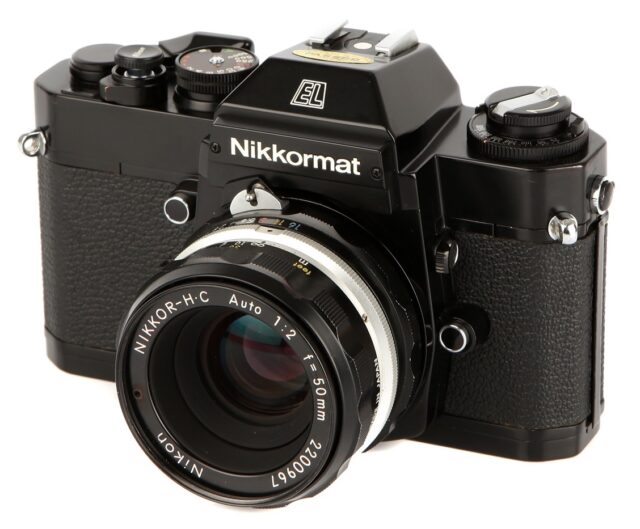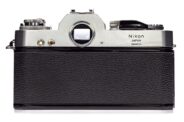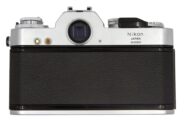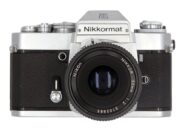Announced
Production status
System
Nikon F system cameras
- Nikkorex F
- Nikkormat EL
- Nikkormat ELW
- Nikkormat FS
- Nikkormat FT
- Nikkormat FT2
- Nikkormat FT3
- Nikkormat FTN
- Nikon D3
- Nikon D3s
- Nikon D3X
- Nikon D4
- Nikon D4s
- Nikon D5
- Nikon D6
- Nikon D600
- Nikon D610
- Nikon D700
- Nikon D750
- Nikon D780
- Nikon D800
- Nikon D800E
- Nikon D810
- Nikon D850
- Nikon Df
- Nikon EL2
- Nikon EM
- Nikon F
- Nikon F100
- Nikon F2
- Nikon F3
- Nikon F4
- Nikon F5
- Nikon F6
- Nikon FA
- Nikon FE
- Nikon FE10
- Nikon FE2
- Nikon FG
- Nikon FG-20
- Nikon FM
- Nikon FM10
- Nikon FM2
- Nikon FM2/T
- Nikon FM3A
- Nikon N2000
- Nikon N2020
- Nikon N4004
- Nikon N4004S
- Nikon N50
- Nikon N5005
- Nikon N55
- Nikon N60
- Nikon N6000
- Nikon N6006
- Nikon N65
- Nikon N70
- Nikon N75
- Nikon N80
- Nikon N8008
- Nikon N8008S
- Nikon N90
- Nikon N90S
Nikkormat EL
35mm MF film SLR camera • Discontinued
Specification
| Format: | |
| 35mm full frame | |
Film type: | 135 cartridge-loaded film |
| Nikon F [46.5mm] | |
| Shutter: | |
Type: | Focal-plane |
Model: | Electronically controlled |
Speeds: | 4 - 1/1000 + B |
| Exposure: | |
Exposure metering: | Through-the-lens (TTL), open-aperture |
Exposure modes: | Aperture-priority Auto |
| Manual | |
| Physical characteristics: | |
Weight: | 780g |
Dimensions: | 145x93.5x54.5mm |
Manufacturer description #1
Nikkormat EL provides fully automatic, aperture-priority, through-the-Iens exposure control. The photographer selects the lens opening, and the camera's computer circuit automatically sets the precise shutter speed for correct exposure from 4 seconds to 1/1000th second... with speeds continuously variable within this range. Exposure may also be controlled manually.
The Nikkormat EL is designed for photographers who prefer the convenience of automatic exposure control but also insist on Nikon quality and versatility. The EL's through-the-Iens meter automatically selects and sets the exact shutter speed for perfect exposure, steplessly and continuously from 4 full seconds to 1/1000th second. Because it is an aperture-priority system, this automatic precision may be enjoyed with more than 55 reflex-viewing Nikkor lenses, with bellows units, extension rings, even microscopes and telescopes.
Automatic Exposure Control
Move shutter dial to automatic position, choose desired lens aperture - and take the picture! When you press the shutter release, the through-the-Iens meter relays its exposure command to the camera's electronic circuit, which selects the correct shutter speed automatically. Speeds are continuously variable from 4 seconds to 1/1000th. The meter gives full-aperture measurement with all meter-coupled Auto-Nikkor lenses (including all AI-Nikkors); also permits stop-down metering with uncoupled lenses or accessories. And, the center-weighted system is equally reliable with camera held in vertical or horizontal position. Manual operation may be selected at any time by moving shutter dial off "A" and adjusting shutter speed or lens aperture for match-needle exposure control.
Exposure Memory Lock
In automatic operation, the photographer can "lock in" specialized exposure readings by moving the self-timer lever towards the lens; indicated speed is retained as long as lever is held. This provides valuable control for selective closeup readings, or when deliberate under- or over-exposure is desired.
Nikon Center-Weighted Metering
Most consistently accurate of all metering systems. Reads entire picture area but concentrates more than half of its sensitivity on the central 12mm-diameter portion, shown by circle in finder. Assures correct exposure under virtually any conditions. ASA range 25-1600; sensitivity range EV 1-18 (1 sec. at f1.4- 1/1000th sec. at f16) with ASA 100 film and f1.4 lens.
3-Way Focus Check
Permits fast, accurate focusing even in dim light or with wide-angle lenses. Central split-image rangefinder is surrounded by microprism collar and overall Fresnel-type groundglass. Finder provides exceptional edge-to-edge viewing brilliance; also shows shutter speed in use plus complete shutter- speed display, under/over-exposure zones, auto and match-needle markers.
Electronically Controlled All Metal Shutter
Provides speeds from 4 seconds to 1/1000th, continuously variable in automatic mode, and "B." Speeds are timed electronically by unique integrated circuit encompassing nearly 100 solid-state components, assuring outstanding speed accuracy. Shutter is linked to meter system by Nikon-designed Functional Resistance Element (FRE) with gold-plated contacts for lasting reliability. Shutter and meter are powered by 6v silver-oxide battery. Mechanical speed of 1/90th second available in case of battery depletion. LED battery check on back of camera.
Full Flash Capability
"X" synch at speeds to 1/125th second; "M" synch at all speeds. Locking synch selector on shutter dial. Built-in hot shoe, with safety switch for positive shock prevention, for Nikon and other cordless flash units. PC outlet accepts Nikon screw-in or conventional PC cords.
Convenient Operation
Plastic tip-cushioned transport lever advances film, winds shutter, counts exposures and switches meter on in single 135 deg. stroke; automatically returns to 30 deg. stand-off "ready" position with meter on; when returned flush with body, turns meter off. Hinged back and multi-slotted take-up spool speed film loading. Superior film flatness, vital for edge-to-edge sharpness, is achieved with combination of extra-long pressure plate and film rails, cartridge stabilizer, and emulsion-side-out winding onto take-up spool.
Other Features
Built in self-timer; depth-of-field preview; oversize instant-return mirror with lock control; folding film-rewind crank; stainless steel reinforced neckstrap eyelets. Nikkormat EL is supplied in satin chrome finish (Product No. 1822) or professional black finish (Product No. 1826).
Manufacturer description #2
CAMERA TYPE: Automatic 35mm SLR with through-the-Iens CdS metering and interchangeable lenses.
LENSMOUNT: Stainless-steel Nikon bayonet accepts all Nikkor lenses 6mm-2000mm and all Nikon-mount accessories. Flange/film distance 46.5mm. Automatic diaphragm coupling.
EXPOSURE CONTROL: Automatic through-the-Iens with aperture priority; manual match-needle with aperture or shutter priority.
METER SYSTEM: CdS cells concentrate 60% of sensitivity on central 12mm area shown by circle in finder; operates at full aperture with all meter-coupled Auto-Nikkor and AI-Nikkor lenses; stop-down measurement with non-coupled lenses, attachments, or instruments.
METER RANGES: ASA 25-1600; EV 1 to 18 (with ASA 100 film and f1.4 lens). Full-aperture coupling range: f1.2-f32.
AUTOMATIC EXPOSURE MEMORY LOCK: Built in, operated via self-timer lever.
SHUTTER: Electronically-timed, all-metal vertical-travel focal plane; speeds "B", 4, 2, 1, 1/2, 1/4, 1/8, 1/15, 1/30, 1/60, 1/125, 1/250, 1/500, and 1/1000th second in manual mode; continuously variable 4-1/1000th second in automatic mode. Shutter operates at 1/90th second in manual mode if battery is depleted.
FLASH SYNCHRONIZATION: "X" synch at "B" to 4-1/125th second; "M" synch at "B", 4-1/1000th second; locking synch selector on shutter speed dial.
FLASH CONTACTS: Built-in hot shoe with automatic safety switch; single PC outlet accepts Nikon screw-on or conventional PC cords.
VIEWFINDER: Built-in pentaprism finder with -1.0 diopter correction; information display includes meter needle, under/over-exposure indicators, auto/manual signal, shutter speed in use, and complete shutter speed scale.
FOCUSING SCREEN: Fixed Nikon Type K screen with 3mm-diameter split-image rangefinder, 1mm microprism circle plus overall matte Fresnel area; large circle shows center-weighted measurement area.
REFLEX MIRROR: Oversize instant-return type with independent locking control.
FILM LOADING: Multi-slotted take-up spool, hinged back and additive automatic-reset exposure counter for fast loading.
FILM TRANSPORT: Single-stroke lever advances film, winds shutter, switches meter on, and counts exposures in 135 deg. action, may be left at "ready" position 30 deg. from camera body, to activate meter; when folded flush, lever turns meter off and locks shutter release.
FILM REWIND: Rewind-release button on camera baseplate; fold-out rewind crank pulls up to open camera back, after safety catch is released.
BATTERY TYPE: One 6v silver oxide battery (Eveready 544 or equivalent) powers meter and shutter; battery tester built in.
OTHER FEATURES: Depth-of-field preview; stainless-steel reinforced neckstrap eyelets; built-in self-timer with variable delay to approximately 10 seconds.
Similar cameras (4)
35mm full frame • Manual focus • Film • Singe-lens reflex • Nikon F mount
| Model | Shutter | Metering | Modes | Year |
|---|---|---|---|---|
| Kiev-17 aka Киев-17 |
M, 1/1000 | -- | M | 1978 ● |
| Kiev-19 aka Киев-19 |
M, 1/500 | TTL • WA | M | 1985 ● |
| Kiev-19M aka Киев-19М |
M, 1/500 | TTL • OA | M | 1988 ● |
| Kiev-20 aka Киев-20 |
M, 1/1000 | TTL • OA | M | 1983 ● |







